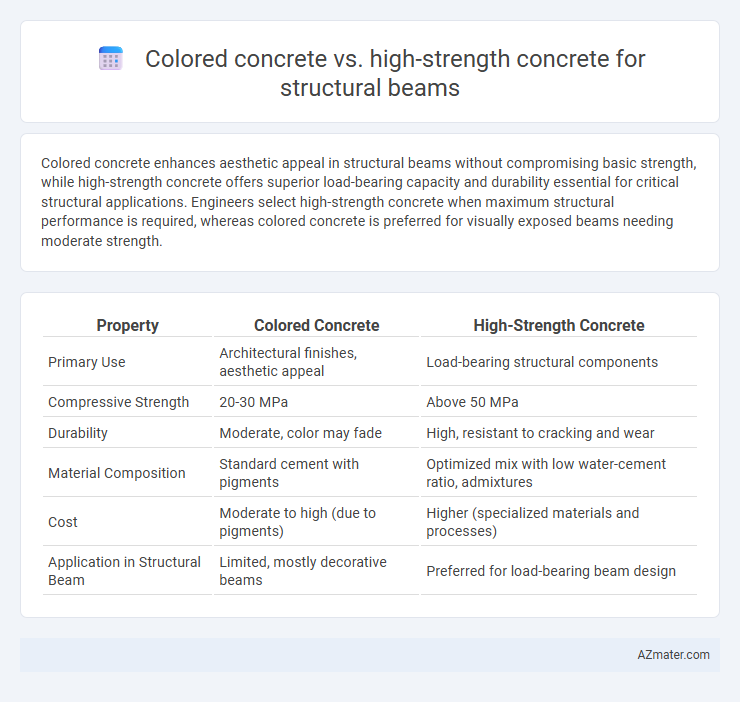Colored concrete enhances aesthetic appeal in structural beams without compromising basic strength, while high-strength concrete offers superior load-bearing capacity and durability essential for critical structural applications. Engineers select high-strength concrete when maximum structural performance is required, whereas colored concrete is preferred for visually exposed beams needing moderate strength.
Table of Comparison
| Property | Colored Concrete | High-Strength Concrete |
|---|---|---|
| Primary Use | Architectural finishes, aesthetic appeal | Load-bearing structural components |
| Compressive Strength | 20-30 MPa | Above 50 MPa |
| Durability | Moderate, color may fade | High, resistant to cracking and wear |
| Material Composition | Standard cement with pigments | Optimized mix with low water-cement ratio, admixtures |
| Cost | Moderate to high (due to pigments) | Higher (specialized materials and processes) |
| Application in Structural Beam | Limited, mostly decorative beams | Preferred for load-bearing beam design |
Introduction to Colored and High-Strength Concrete
Colored concrete incorporates pigments that provide diverse aesthetic options without compromising its basic structural properties, making it ideal for architectural beams where visual appeal is important. High-strength concrete, designed to achieve compressive strengths above 6,000 psi, is engineered for structural beams that require superior load-bearing capacity and durability in demanding construction projects. Both types serve distinct roles in beam applications, with colored concrete emphasizing design flexibility and high-strength concrete prioritizing performance and structural integrity.
Understanding Structural Beam Requirements
Colored concrete enhances aesthetic appeal but typically exhibits lower compressive strength compared to high-strength concrete, which is specifically engineered for superior load-bearing capacity in structural beams. Structural beam requirements prioritize factors such as compressive strength, stiffness, and durability, making high-strength concrete more suitable for critical load zones and heavy structural demands. While colored concrete is useful for architectural finishes, it may require reinforcement or specialized mixes to meet the mechanical performance essential for structural beam applications.
Composition and Properties of Colored Concrete
Colored concrete incorporates pigments such as iron oxides and synthetic dyes into the traditional cement, aggregates, and water mix, offering aesthetic versatility without compromising basic structural integrity. Its compressive strength typically ranges from 20 to 40 MPa, depending on the mix design, which is generally lower than high-strength concrete that exceeds 60 MPa by using low water-cement ratios, silica fume, and superplasticizers. While colored concrete prioritizes visual appeal and customizable finishes, high-strength concrete is engineered for superior load-bearing capacity and durability in structural beams.
Characteristics of High-Strength Concrete
High-strength concrete used in structural beams exhibits superior compressive strength, typically exceeding 6,000 psi, enabling it to support heavier loads with reduced cross-sectional dimensions. Its dense microstructure results in enhanced durability, lower permeability, and improved resistance to chemical attacks and environmental degradation. Unlike colored concrete, which prioritizes aesthetic appeal with pigments and surface finishes, high-strength concrete emphasizes mechanical performance and longevity in critical load-bearing applications.
Aesthetic Value: Colored Concrete in Structural Beams
Colored concrete in structural beams enhances aesthetic value by offering a wide range of hues and finishes that integrate seamlessly with architectural designs, providing a visually appealing alternative to traditional gray concrete. Its pigmentation resists fading and weathering, ensuring long-lasting color vibrancy, which is crucial for exposed structural elements. Unlike high-strength concrete, which prioritizes performance metrics such as compressive strength and durability, colored concrete balances structural integrity with customization, making it ideal for projects where visual impact is paramount.
Performance and Load-Bearing Capacity Comparison
Colored concrete typically exhibits lower compressive strength and load-bearing capacity compared to high-strength concrete, which is engineered to achieve compressive strengths exceeding 6,000 psi, making it ideal for structural beams in high-load applications. High-strength concrete enhances structural performance through improved durability, reduced beam size, and increased resistance to cracking under heavy loads. While colored concrete offers aesthetic benefits, high-strength concrete is superior in optimizing beam performance and ensuring safety under significant structural stresses.
Durability and Longevity Considerations
Colored concrete offers aesthetic versatility but typically has similar durability to standard concrete, with pigmentation additives having minimal impact on its structural integrity. High-strength concrete, designed for superior compressive strength (often exceeding 6,000 psi), enhances beam durability by resisting cracking, wear, and environmental stressors more effectively over time. Selecting high-strength concrete for structural beams ensures longer service life and improved performance in load-bearing applications compared to colored concrete, which prioritizes appearance without substantially increasing longevity.
Cost Analysis: Colored vs High-Strength Concrete
Colored concrete typically incurs higher initial costs due to pigment additives and specialized mixing processes, while high-strength concrete involves increased expenses primarily from advanced cementitious materials and admixtures designed to enhance performance. Maintenance and lifecycle costs often favor high-strength concrete, as its superior durability and load-bearing capacity reduce repair frequency and extend structural longevity. Budget planning for structural beams demands careful evaluation of upfront material costs against long-term savings influenced by the performance characteristics of colored versus high-strength concrete.
Environmental Impact and Sustainability
Colored concrete often incorporates pigments without significantly altering the material's environmental footprint, whereas high-strength concrete typically demands higher cement content, increasing CO2 emissions during production. The sustainability of colored concrete can be enhanced by using recycled aggregates and eco-friendly pigments, reducing resource extraction and waste. High-strength concrete, while allowing smaller beam dimensions and less material use, requires careful mix design to optimize performance and minimize its carbon footprint.
Choosing the Right Concrete for Your Structural Beam
Choosing the right concrete for your structural beam depends on the specific project requirements and performance criteria; colored concrete primarily serves aesthetic purposes without compromising standard structural integrity, while high-strength concrete offers enhanced load-bearing capacity and durability. High-strength concrete typically has a compressive strength above 6,000 psi, making it ideal for beams subjected to heavy loads and demanding structural conditions. Colored concrete can be used effectively in architectural beams where visual appeal is important, but structural safety and strength should always prioritize high-strength concrete selection when critical load resistance is necessary.

Infographic: Colored concrete vs High-strength concrete for Structural Beam
 azmater.com
azmater.com